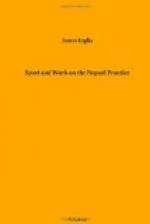‘It would be a wonder if there was,’ rejoined the laird, without the movement of a muscle, ‘it’s ten years since I saw him gang in there.’
So it is sometimes with a native. He will fire your ardour, by telling you of some enormous tiger, to be found in some jungle close by, but when you come to enquire minutely into his story, you find that the tiger was seen perhaps the year before last, or that it used to be there, or that somebody else had told him of its being there.
Some tigers, too, are so cunning and wary, that they will make off long before the elephants have come near. I have seen others rise on their hind legs just like a hare or a kangaroo, and peer over the jungle trying to make out one’s whereabouts. This is of course only in short light jungle.
The plan we generally adopt in beating for tiger on or near the Nepaul border, is to use a line of elephants to beat the cover. It is a fine sight to watch the long line of stately monsters moving slowly and steadily forward. Several howdahs tower high above the line, the polished barrels of guns and rifles glittering in the fierce rays of the burning and vertical sun. Some of the shooters wear huge hats made from the light pith of the solah plant, others have long blue or white puggrees wound round their heads in truly Oriental style. These are very comfortable to wear, but rather trying to the sight, as they afford no protection to the eyes. For riding they are to my mind the most comfortable head-dress that can be worn, and they are certainly more graceful than the stiff unsightly solah hat.
Between every two howdahs are four or five pad elephants. These beat up all the intervening bushes, and carry the game that may be shot. When a pig, deer, tiger, or other animal has been shot, and has received its coup de grace, it is quickly bundled on to the pad, and there secured. The elephant kneels down to receive the load, and while game is being padded the whole line waits, till the operation is complete, as it is bad policy to leave blanks. Where this simple precaution is neglected, many a tiger will sneak through the opening left by the pad elephant, and so silently and cautiously can they steal through the dense cover, and so cunning are they and acute, that they will take advantage of the slightest gap, and the keenest and best trained eye will fail to detect them.
In most of our hunting parties on the Koosee, we had some twenty or thirty elephants, and frequently six or eight howdahs. These expeditions were very pleasant, and we lived luxuriously. For real sport ten elephants and two or three tried comrades—not more—is much better. With a short, easily-worked line, that can turn and double, and follow the tiger quickly, and dog his every movement, you can get far better sport, and bring more to bag, than with a long unwieldy line, that takes a considerable time to turn and wheel, and in whose onward march there is of necessity little of the silence and swiftness which are necessary elements in successful tiger shooting.




